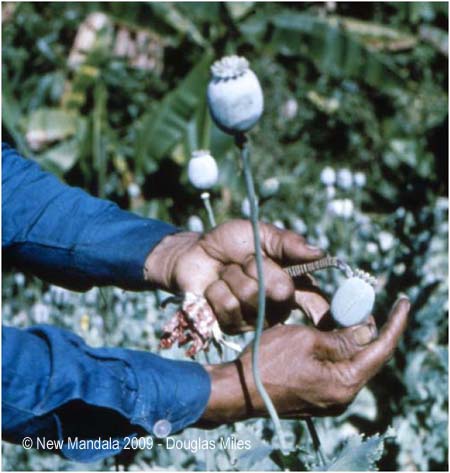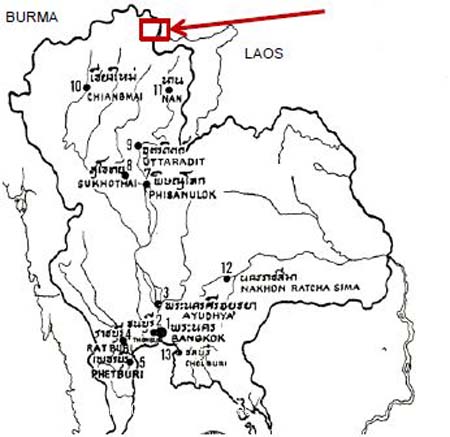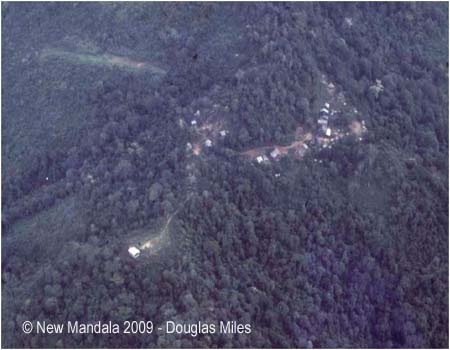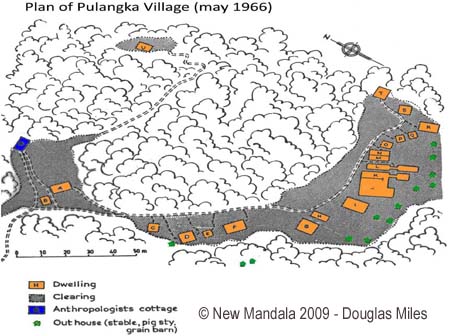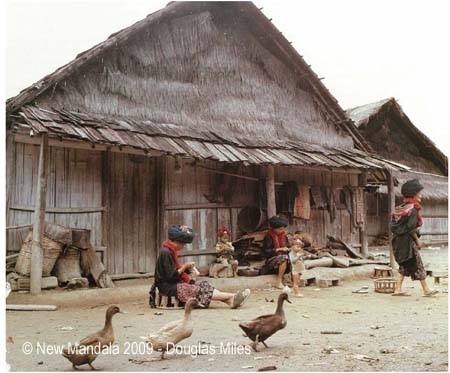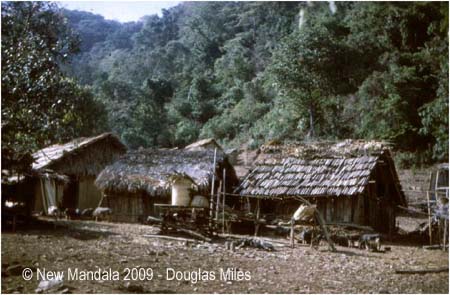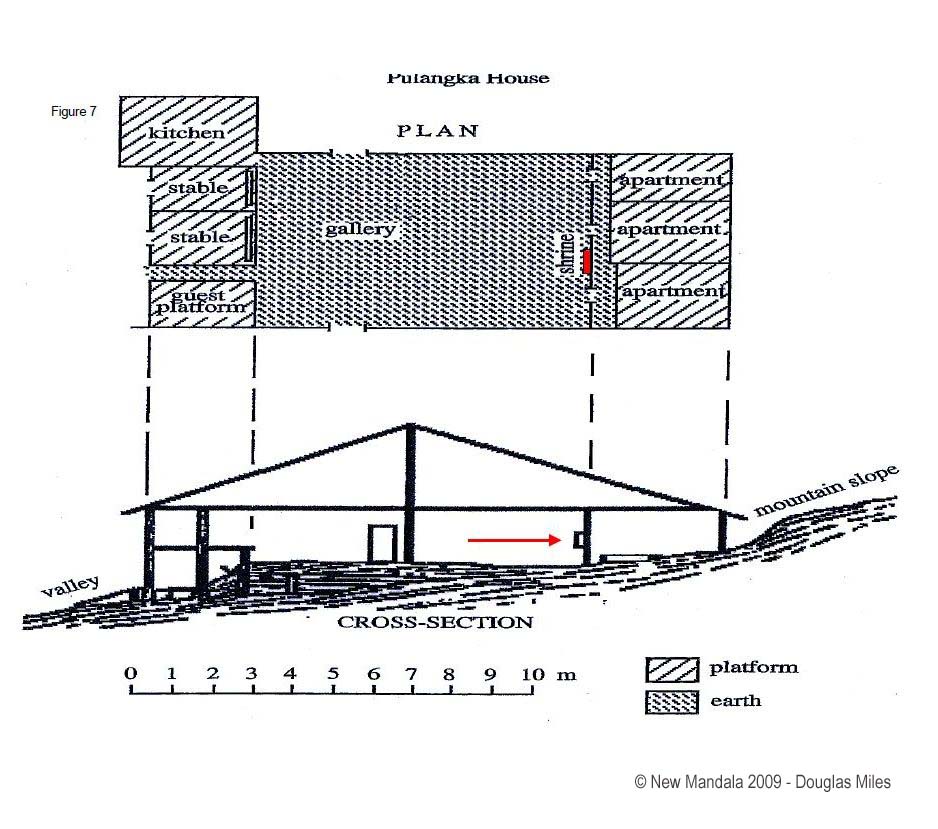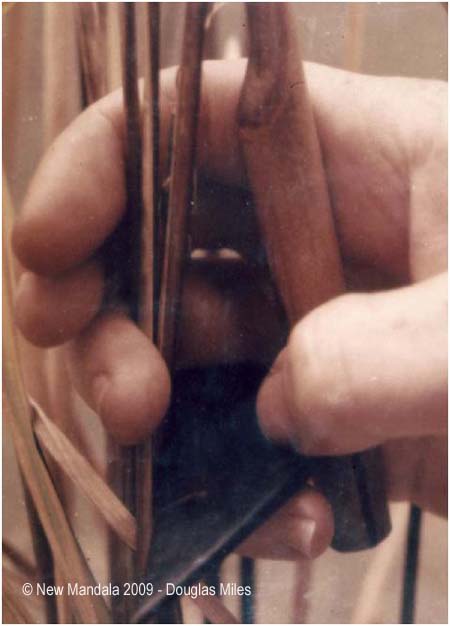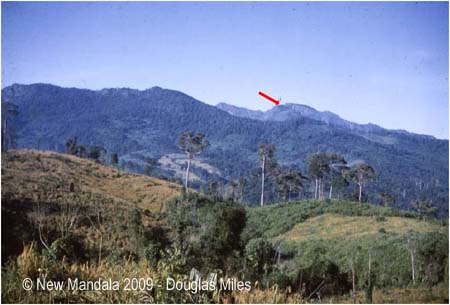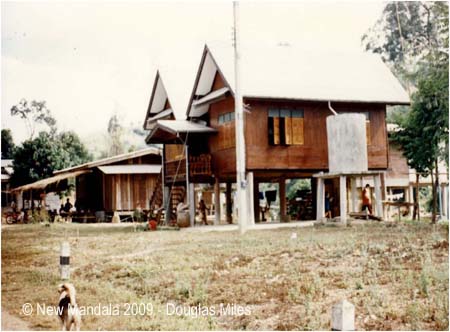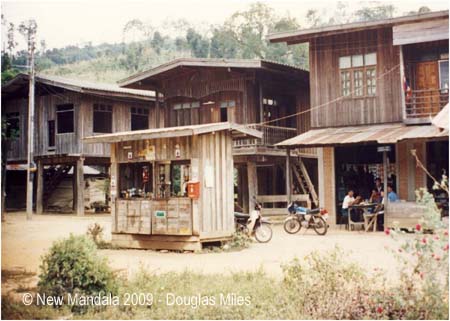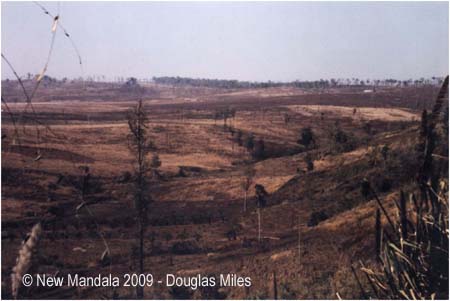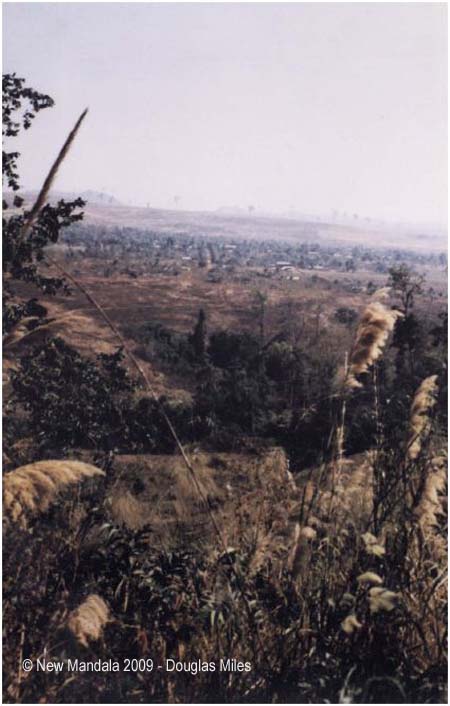Image 1: Supplementary incising of a poppy capsule with a three-pronged scalpel. Yao who have worked elsewhere compare the intensity and delicacy of the task with embroidery.
Off-farm and Beyond Ockham in the Northern Thai Highlands: Further Philosophising on Opium, Overseas Aid and the Applied Anthropology of Tropical Agricultural Development
Douglas Miles (Anthropology, James Cook University, ex Tribal Research Centre, Chiang Mai University, CIU Ascona)
This paper was originally presented at the 2007 Australian Anthropology Society Annual Conference, The Australian National University, Canberra.
Researching Sustainability among Yao Poppy Growers
During much of my fieldwork (1968-69) among the Yao of Pulangka village in the northern Thai highlands, my professional and self-imposed pre-occupations were with the fine-grained observation and preliminary analysis of the proven sustainability which characterised their system of shifting cultivation in environmental , demographic and economic terms. (Sustainability was “proven” by the continuous growth in the prosperity of the community which succeeded in remaining largely sedentary by using extended fallowing cycles of about 15 years from the 1880s till 1968.)
Image 2: The red arrow points out the approximate extent of the vast range within which the swiddens (both undercrop and fallow ) of Pulangka farmers (1950-68) were located.
Image 3: View (1967) of Pulangka Village from peak of Mt. Phachangnoi. Note the extent, proximity and maturity of climax jungle fallow.
Image 4: Plan of Pulangka Village (1966) (House R is shown in Image 6).
I held an appointment as an anthropological fieldworker with the Tribal Research Centre on Chiangmai University campus under an agreement between Australia’s then Department of External Affairs and the Royal Thai Ministry of Social Welfare.
One of the priorities of my assignment was to gather and collate information which might facilitate the phasing-out of opium production with minimal detrimental impacts on the agricultural system and prosperity of the Pulangka Yao. This was explicitly a case study and the findings were expected to have applicability to other communities and other regional ethnic groups whose farmers grew poppy.
Image 5: Yao grandmothers conventionally embroider together when relaxing with neighbours in a typical village dwelling’s forecourt. (Photo by the late Dr. Chob Kachananda).
Image 6: House R (1966) in Plan of Pulangka Village (Image 4).
Image 7: Yao house plan (click for larger image)
My concentration on the details of multicropping by these people (Miles, 1979) allowed me to give little or no thought and time to one set of the factors which in retrospect were to prove very relevant to the interests I have just outlined even though they operated “off-farm” and far beyond my focus of attention on the particularities of the various Pulangka crops.
Image 8: Harvesting Rice with the Yao finger knife.
Image 9: Natural template for reading of Pulangka’s recent agricultural history. The photographer’s view south from a rice swidden during its harvest in 1967 extends across the sites of previous maize and rice swiddens at all phases of fallow to poppy fields which are simultaneously being weeded on the most distant peak (see red arrow).
I refer to the capacity of the Thai military forces to terminate opium production by minority communities anywhere in the Kingdom. Indeed, the Royal Thai Army (3rd Region) was to prove crucial to the continuity of Pulangka’s agricultural system which after almost half a century of operation in the same location, a military deployment was able to render permanently unsustainable in merely a few days.And that is what I witnessed during late February 1968 when my ” fine-grained” ethnographic fieldwork ended prematurely with the bombing of Pulangka village by a Royal Thai Airforce squadron and the seeding with landmines of the surrounding farmlands under both crop and fallow (Miles, 2007: 253-256).
That attack on a civilian population and its resources initiated the complete evacuation not only of this Yao settlement but also of all villages and hamlets ( Yao, Hmong and Thai) in the rugged mountain belt which forms the most inaccessible section of the Kingdom’s northernmost frontier with Laos. The exodus of highlanders was largely effected by the immediately subsequent intrusion into to all bombed settlements by the Royal Thai Army (3rd Region) some of whose work-parties set fire to dwellings and ransacked outhouses (stables, granaries, pig pens etc) while other units manually planted mines in the vicinity of those constructions and in all swiddens at or above the minimum altitude (1000 metres) required by the poppy crop. Any likelihood of even a temporary return by the Yao fugitives appeared to have been totally eliminated. Poppy growing in the area had been permanently terminated by denying the crop the human labour essential for its cultivation.
While the bombs were falling , all inhabitants (including my wife who was the village schoolteacher and our four-year old daughter) had fled together and had finally taken refuge in a valley where the villagers had erected a number of bush shelters in an abandoned and fallowing maize swidden belonging to our next-door neighbour. This camp was under a rocky outcrop called Pangka where at first most of the fugitives crouched shivering for hours behind a waterfall immediately below the mountain settlement until some completed temporary repairs on a few dilapidated farmhuts near the rivulet’s bank and on collapsing granaries and stables which were even more overgrown by regenerating jungle spreading from adjacent fallow maize swiddens.
During the months (and then the years) which followed, the Yao gradually replaced such emergency accomodation with more durable structures and, eventually, with permanent dwellings. Today they own and occupy Siamese-style teak bungalows with sturdy floors above the foundation stumps of earlier premises and with satellite saucers and/or pick-up trucks in front of half of them . The campsite of yore has become Pangka Village with a population of almost 800. Together with a few shops and several other businesses in between (such as a petrol station, automobile repair workshop, hairdressing salon, TV and computer servicing centre) these buildings now comprise an outer “suburb” which a new highway links to Payao Province’ s largest central market in Chiengkham town only 40 minutes drive away.
Image 10: Typically Thai-style Houses of Yao in Pangka (1997), where the refugee Yao of Pulanka have now settled.
Image 11: Main Street, Pangka village (1997): gas station, offices, houses and noodle bar.
Contrasts with the Hmong in Tung Yai Naresuan National Park
Note that the Yao case study manifests only one variant of the strategy which the Thai military developed after the mid-1960s to inflict permanent unsustainabity upon an agricultural system which had provided highland farmers of the Kingdom with constantly increasing prosperity from the turn of the 19th Century into the 20th and until the early 1970s.
The Royal Thai Army (3rd Region) continued to use the tactics I have just described to terminate poppy growing throughout north Thailand for at least another decade after 1968 but during that time the military also “researched and developed” more sophisticated variants of possible tactics to achieve the same end along the western frontier with Burma. That region includes mountainous territory which extends throughout Mae Hong Son , Mae Sariang and Tak and which royal decrees have recently dedicated as “wild life sanctuaries and botanical reserves.” I refer to landscape whose uplands have been traditional habitat not only for a number of poppy growing ethnic groups (eg Akha, Lahu, Karen and Lisu ) with populations concentrations in Burma also and for even more generations for Hmong opium producers.
Such legislation entails a strict prohibition on forest felling and on log removal (except under government licence); also, against the sealing of roads. The “parkland” (as the terrain in question is commonly designated in legislation and in the media) includes for example Thung Yai Naresuan which straddles mountain ridges between Tak and Kanchanaburi Provinces. This is Thailand’s first national park and on which I focus the following comments on the Hmong poppy growers who have now abandoned the place.
My visit to their former habitat in 1988 (as a guest of Khun Boonsong Lekagul in an excursion of the Bangkok Birdwatching Club) provided me with an opportunity to compare the strategy of ending poppy growing by landmining with a different method for achieving the same end: licensed commercial clear-felling. This also entails forced eviction of opium producers from their land but at military gun point (rather than as fugitives from bombardment). Army rifles (rather than landmines) have likewise obstructed long-term return to highland domicile by the former Hmong residents and their resumption of shifting cultivation on their deserted farmlands. But the main difference between the two cases I am comparing is in the degree of risk to which each method of eradicating poppy production subjects human lives.
Landmining succeeds largely by virtue of fostering enduring uncertainty about where the demolition squads of the past have planted lethal explosives (by activating the devices randomly and without documentation). Such risk to life reveals why the tactic has proved persistently and totally effective in obstructing opium production around Pulangka for more 40 years. (Note that the mines have ironically provided some benefits to the environment because jungle vegetation has thrived where there has been no swiddening for forty years.)
But the Royal Thai Army (3rd Region) of the 90s was proud to have become “New- Age” as well as “High Tech” and to have replaced landmining with another method to end poppy growing with less risk of domestic and international outrage by humanists. (Note that I have yet to make any mention of Thai Buddhist counterparts to both wild animal lovers in the West and to tree-hugging environmentalists.)
My attention focusses on procedures which did more than deny human labour to the cultivation of swiddens at suitable altitudes (>1,000 m) for poppy-growing and I emphasise the obvious point that the sustainability of such farms also has botanical prerequisites which include the quality of the jungle (preferably primary or climax regrowth) that is the source of the nutrients on which the crop depends. The transformation of these into ash on site is one of the main attributes of the slash-and-burn technique.
During the1980s and the 1990s, Thailand demonstrated to its own satisfaction that the Kingdom could curtail opium production completely , effectively and permanently by outsourcing the clear felling of such jungle in parklands to lumber companies. The strategy proved hugely profitable to all (apart from the Hmong and the wildlife in the “refuge”) and especially to the trucking firms which effected the extraction of trees as bark stripped logs in convoys of bumper-to-bumper jinkers on temporary and unsealed roads which 24/7 linked ultimately with the national highway system. Arc lights enabled 24 hour operations at the felling sites. (Note also that no deaths necessary to deter poppy growing whereas landmines around Pulasngka made fatalities and maiming inevitable there.)
Military constraints ensured minimisation of media reports about these operations and a few of my own photographs must therefore suffice to convey to you the reality of the monstrous extent, intensity and permanence of the deliberate destruction which clear felling of jungle fallow has inflicted on the agricultural and environmnental potential of the landscape depicted. The pictures record the permanent unsustainability which the removal of all jungle growth has imposed not only upon poppy farming but on all forms of shifting cultivation in the parkland of Tung Yai Narasuen. As you can see, the only flora now reproducing itself on this terrain even eight years after clear felling was the weed imperata cylindrica (which is none other than the dreaded kunai grass of PNG and the noxious alang of Indonesia/Malaysia ) whose self-seeding condemns the land on which it grows to permanent agricultural uselessness. In 1997 the place still retained the appearance of an open cut mine and remained more comparable to a “moonscape” than a landscape.
Image 12: Phro Phra Wild Life Sanctuary in 1988. Note absence of jungle re-growth.
Image 13: Imperata Cylindrica thriving in Thung Yai Naresuan National Park, 1988.
And as the birdwatchers lamented, there was no longer even a flicker of wildlife in this so-called “sanctuary” which is still famous among international hunters for the herds of indigenous gigantic cattle (koepri; bos gaurius) which used to thrive there. (The location is also notorious for the political significance a notorious hunting expedition which targeted these animals from an Army helicopter that crashed there in 1973 in onset of street demonstrations in Bangkok which brought down the regime which ruled Thailand until October of that year.)
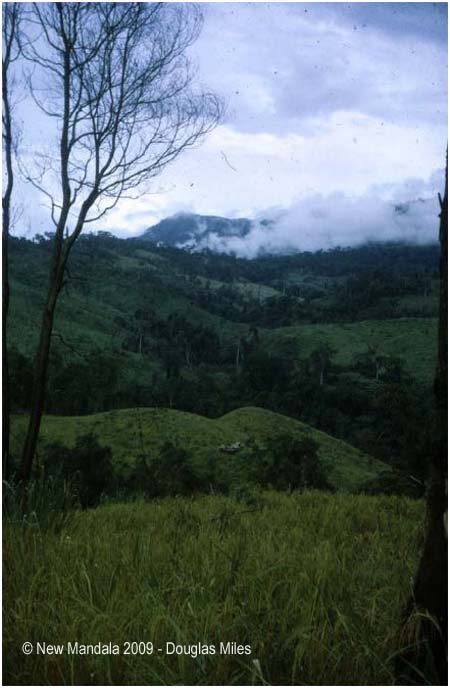
Image 14: Back in the region of Pulangka (1998) where there has been no felling of jungle for thirty years.
Implications and Conclusions
A comparison of the two case studies adds philosophical questions to practical problems about the incompletion more than 40 years ago, of my research into the then “proven sustainability” of Pulangka’s agricultural system. The bombardment and landmining of that village and its swiddens were intended to deprive the poppy of the human labour necessary for its cultivation and has done so for four decades . In the Hmong case by contrast, elimination of the jungle by commercial clear felling permanently denied poppy growersd the nutrients which the enterprise required and which the farmers could make available on site through their slash-and burn techniques.
Finally, I ask you to consider whether the “off-farm” events I have described have made my incomplete field observations and measurements of Yao agriculture entirely futile and I close by inviting the seminar to discuss whether the applied anthropology of tropical agricultural development can have any professional justification where the state so patently disconnects the future of the farms from the opportunity for the farmers themselves to decide on how to pursue their best interests.
References
Miles, Douglas 1979 “The Finger Knife and Okham’s Razor” A Problem in Culture History and Economic Anthropology” American Ethnologist Vol 6, No2, pp 223 -43.
Miles, Douglas 2008 , “Afternoon Light on the ‘Thailand Controversy’ : an Afterword” TAPJA Vol 9, N0 3, pp253-262.
Acknowledgement
Thanks to Mr. Sanjay of CIU Ascona, Switzerland for availing me of both his program and technical expertise to process and deliver the text and illustrations in record time.
Douglas Miles “pioneered Anthropological studies of Southeast Asia in Australia, through major fieldwork among the Ngadju Dayaks of Borneo (1959-60, 1961-63) and the Yao of Northern Thailand and Laos (1966-69, 1970, 1996-97). Furthermore, he undertook innovative research on contemporary Indonesian culture, such as the sociology of oral and written literature on Bali and associated research on shadow puppetry and the economics of flower production (1974-75, 1978), as well as on the work of the playwright and actor W. S. Rendra. His influence extended to several generations of Australian students in his appointments at the University of Sydney (1969-1983), The Australian National University (1983-1993) and, latterly, at James Cook University (1993-present).” From Connecting the Miles: Introduction by Jennifer Alexander, Rosita Henry and Kathryn Robinson, The Asia Pacific Journal of Anthropology, Vol. 9, No. 3, September 2008, pp. 175-176.
 Facebook
Facebook  Twitter
Twitter  Soundcloud
Soundcloud  Youtube
Youtube  Rss
Rss 